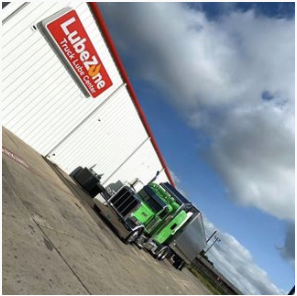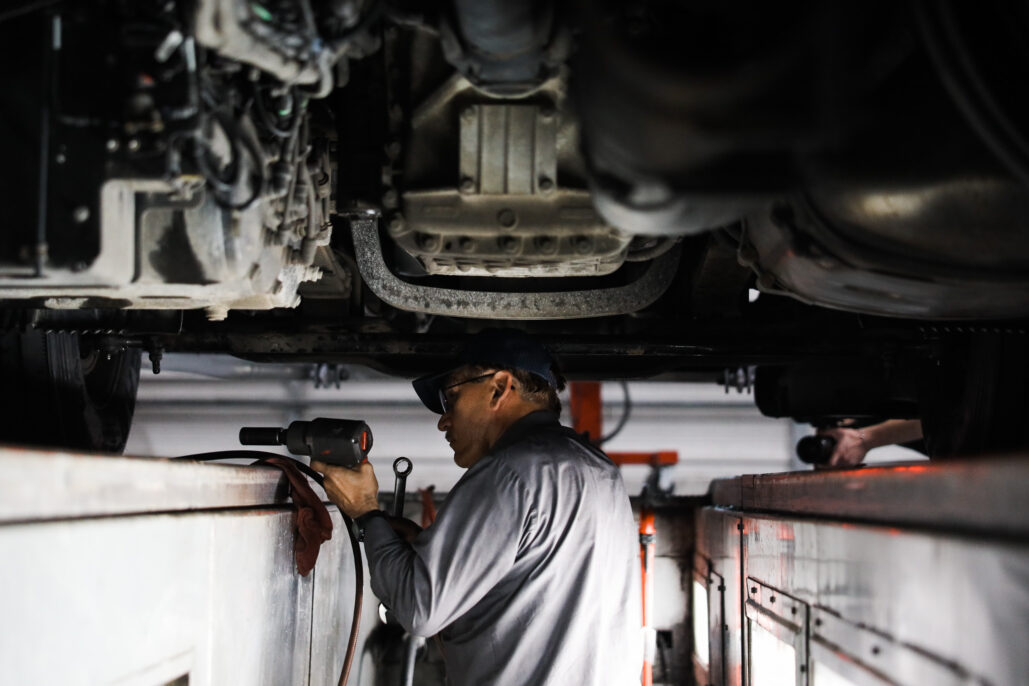
The Ultimate DOT Inspection Checklist for Owner-Operators
June 27, 2025
Optimizing Diesel Fuel Efficiency: A Comprehensive Guide
October 7, 2025Recently updated on October 14th, 2025
The effects of poor truck maintenance hit hard. Missed services lead to breakdowns, inspection failures, and unexpected repair bills. Drivers lose time. Fleets lose money. Shops charge more to fix what preventive care could have avoided.
When you stay ahead of maintenance, you protect your equipment, reduce truck maintenance costs, and keep your rig running smoothly. Routine service costs less than downtime, and it gives you more control over your schedule and your bottom line.
At LubeZone Truck Lube Center, preventive maintenance is our expertise. We’re breaking down the real cost of neglect and why staying on schedule always pays off.
Why Deferred Maintenance Costs More Than You Think
Skipping scheduled maintenance may seem like a way to save time or money, but the truth catches up fast. Deferred service raises the risk of equipment failure and drives up repair costs. Minor issues can turn into major repairs, reducing your truck’s performance and value.
You’ll face higher truck maintenance costs when a minor problem becomes a full system failure. Some repairs can sideline your truck for days, resulting in thousands of dollars in downtime and lost loads.
Small Problems Become Big Repairs
When you ignore early signs of trouble, minor issues escalate. But simple preventative maintenance can prevent these issues from occurring. Here are some of the most common problems we see.
- Low coolant: Can lead to a blown head gasket or warped engine parts.
- Uneven tire wear: Causes suspension damage or steering problems.
- Dirty air filters Can Reduce fuel efficiency and stress your engine, so it’s essential to keep your air filter clean.
- Failing sensors: Can trigger false codes or hide real mechanical issues.
- Malfunctioning AC: Driver comfort is also important, especially when navigating through extreme climates. Forgoing routine AC tune-ups can cost you big time down the road.
Fixing problems early is always cheaper than waiting until your truck breaks down.
Downtime Is More Expensive Than Service
Emergency repairs do more than increase costs. They leave your rig inactive when you should be earning. Preventive maintenance may take hours, but unplanned downtime can stretch into days.
Lost Hours, Missed Loads, and Driver Frustration
Delays affect your entire operation.
- Missed delivery windows: Lead to chargebacks or lost business.
- Driver delays: Add stress and hurt morale.
- Scheduling problems: Force dispatchers to reshuffle loads.
- Rental or replacement costs: Put pressure on your budget.
A simple breakdown can throw off your schedule for days.
The Cost of Emergency Repairs
Roadside fixes cost more and give you less control.
- After-hours labor rates: Often double normal shop pricing.
- Towing fees: Add hundreds to the bill.
- Parts availability: Can delay repairs.
- Temporary fixes: Often fail again quickly.
Preventive services help avoid these costs and keep your schedule intact.
Damaging Your Truck One Missed Service at a Time
Every missed service shortens your truck’s lifespan. Neglect leads to worn-out parts, higher repair frequency, and rising truck maintenance costs.
Skipped Oil Changes
Oil is your engine’s lifeline. Skipping changes leads to faster wear and costly damage.
- Dirty oil: Fails to protect engine parts.
- Sludge buildup: Clogs filters and passages.
- Excess heat: Damages components under friction.
- Long-term damage: Can lead to engine failure.
Oil changes are one of the cheapest ways to avoid expensive repairs.
Worn Brakes and Tires
Tires and brakes wear out quickly, impacting safety, but an unexpected tire repair is one of the easiest things to prevent. Here are some of the most routine tire and brake issues we see regularly.
- Thin brake pads: Decrease stopping power.
- Warped rotors: Cause vibration and uneven braking.
- Bald tires: Increase the risk of blowouts.
- Misaligned wheels: Cause uneven wear and reduce handling.
Brake and tire issues are common inspection failures and easy to prevent.
Skipping Maintenance Leads to Trouble
The effects of poor truck maintenance become obvious during DOT inspections. Skipped service increases your risk of violations and out-of-service orders.
Failed Inspections and Out-of-Service Orders
Inspectors don’t miss signs of neglect, and they can take your truck off the road effective immediately. This leaves drivers and fleet managers scrambling to make repairs in an effort to recoup lost time on their routes.
- Brake violations: Caused by worn pads or air leaks.
- Lighting issues: Include cracked lenses or dead bulbs.
- Tire problems: Low tread or visible damage.
- Fluid leaks: Signal deeper mechanical problems.
- Unsecured cargo: Points to missed pre-trip checks.
Failed inspections hurt your CSA score, raise insurance costs, and limit load opportunities.
How Poor Maintenance Wastes Fuel
Fuel costs rise fast when your truck isn’t running efficiently. The effects of poor truck maintenance often become apparent first in fuel consumption.
The Link Between Efficiency and Upkeep
Good maintenance means better fuel economy. It keeps your engine running efficiently, reduces strain on critical systems, and helps you get more miles out of every gallon. Here’s the link between efficiency and upkeep:
- Clean air filters: Improve combustion.
- Proper tire inflation: Reduces resistance and fuel burn.
- Accurate sensors: Optimize fuel-air mix.
- Routine oil changes: Reduce engine friction.
- Tuned engines: Burn cleaner and run smoother.
When everything works right, you spend less on fuel.
Small Fixes That Save Thousands in Fuel
Consistent maintenance leads to major savings at the pump.
- Check tire pressure weekly: Even a slight change in pressure can affect your MPG.
- Replace fuel filters on schedule: Prevent restricted flow.
- Keep axles aligned: Misalignment increases drag.
- Inspect belts and pulleys: Worn parts strain the engine.
- Use the correct oil viscosity: Helps engine efficiency year-round.
- Routine tractor and trailer grease: Tractor and trailer grease reduces friction at connection points, preventing wear on the fifth wheel and kingpin.
These habits protect your fuel budget and your bottom line.
Protecting Your Truck for the Long Haul
A well-maintained semi-truck performs better, lasts longer, and costs less to operate. Preventive services protect your investment and help avoid costly surprises.
Maintenance Routines to Extend Lifespan
Sticking to consistent service routines helps catch wear early, reduce breakdowns, and keep your semi-truck on the road longer. These maintenance routines can help extend the lifespan of your truck and engine.
- Oil and filter changes: Prevent internal wear and overheating.
- Cooling system checks: Avoid blown radiators and head gaskets.
- Transmission inspections: Keep shifting smooth and avoid rebuilds.
- Brake service: Keeps your stopping distance short and safe.
- Suspension checks: Maintain ride quality and protect structural components.
Each service visit helps your truck stay productive for longer.
When to Replace vs. When to Maintain
Knowing when to repair a part and when to replace it can help you avoid unnecessary expenses and keep your truck running at peak performance.
- Replace when: Repairs exceed half the part’s value or safety is at risk.
- Maintain when: Parts still perform well within limits.
Preventive maintenance gives you the data to make informed decisions.
Why Preventive Maintenance Is Always Worth It
Preventive service costs less than emergency repairs. It also protects your uptime and reduces surprise expenses. Comparing semi-truck repair vs maintenance costs shows that staying proactive always saves money.
Cost of Average Service vs. Breakdowns
Even basic service tasks cost a fraction of what you’ll pay when parts fail on the road. Here’s how routine maintenance compares to major repair costs.
- Oil change: Around $300. Engine replacement: Over $30,000.
- Brake pad replacement: $250–$400. Rotor and caliper damage: Up to $2,000.
- Tire inspection and rotation: Under $150. Blowouts and damage: Thousands.
- Battery replacement: $200–$400. Roadside service or tows: Much more.
- Scheduled inspection: Keeps you compliant. Failed DOT inspections lead to fines and delays.
The difference is clear. Preventive service protects your rig and your revenue.
Stay Ahead of Repairs with Preventive Maintenance with Service at LubeZone
Preventive maintenance keeps your truck running smoothly, reduces unexpected costs, and protects your time on the road. When you stay on schedule, you avoid the hidden expenses that come with breakdowns, failed inspections, and lost loads.
Visit a LubeZone Truck Lube Center for fast, professional service that helps you stay ahead of problems before they take you off the road.

LubeZone is the fastest growing dedicated semi-truck service in the United States with locations in Texas, California, Oklahoma, North Carolina and Georgia. Our preventative maintenance solutions are designed to get the professional driver back on the road FAST.



